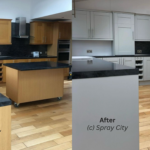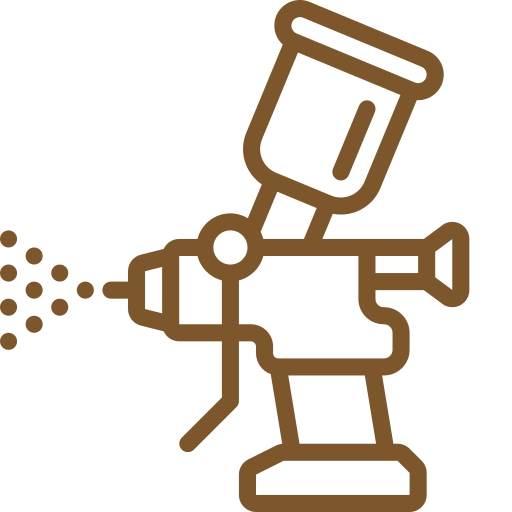Introduction
Are you thinking if you should go for door spraying, door replacing or DIY brush painting?
If you’re looking to give your home a fresh, new look without the cost and hassle of replacing your doors, door spraying might be the perfect solution for you. It is the best cost effective solution and will leave your door as brand new.
This comprehensive guide will walk you through everything you need to know about door spraying, from its benefits and preparation steps to the actual step-by-step process and aftercare.
Be rest assured that based in the UK, Spray City is dedicated to transforming your home with professional, high-quality paint spraying services.

Benefits of Door Spraying
There are numerous advantages to choosing door spraying over traditional brush painting. Here are some key reasons to consider:
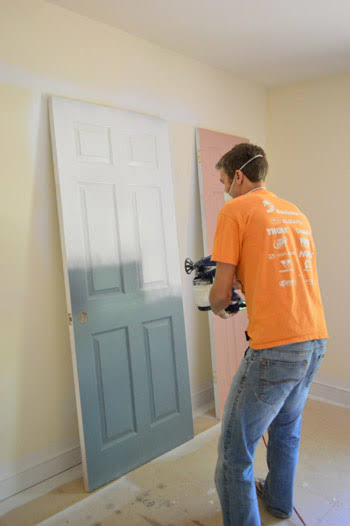
Man spraying a door
Credit: Google Images
-
Cost-Effective:
One of the primary benefits of door spraying is its cost-effectiveness. Replacing doors can be expensive, especially if you have custom sizes or designs and for high-quality materials like solid wood. Spraying your existing doors provides a new look, which is what you want, at a fraction of the cost.
-
Superior Finish:
Spray painting delivers a smooth, professional-looking finish that’s difficult to achieve with a brush. The even application of the sprayer eliminates brushstrokes and roller marks, resulting in a pristine delivery.
-
Faster Completion:
Compared to brush painting, spraying is significantly faster, especially for multiple doors. A single coat applied with a sprayer can cover a large area efficiently, saving you valuable time. Our professional team can typically complete a project within a day or two, greatly reducing the disruption to your daily routine.
-
Improved Efficiency:
Spray painting allows you to reach those hard-to-reach crevices and corners of panelled doors with ease. This ensures complete coverage and a more polished look.
-
Reduced Paint Waste:
Compared to brush painting, spray painting uses less paint as there’s minimal dripping or splashing. This translates to cost savings and less environmental impact.
-
Wider Colour Choice:
Spray paint comes in a wider variety of colours and finishes than traditional paint, including lacquers and metallic finishes, allowing for more creative design options. So whether you prefer a classic white or a bold statement colour, the possibilities are endless.
As a company, we offer thousands of colour options from the RAL Colour Chart and Full Farrow & Ball Range. We are able to give you your exact shade and preference. -
Durability:
Professional door spraying uses high-quality paints and finishes that not only look great but offer excellent durability and a long-lasting finish. The paint adheres better to the surface, creating a more robust layer. Modern paints also offer excellent chip and scratch resistance, ensuring your doors stay looking their best for longer.
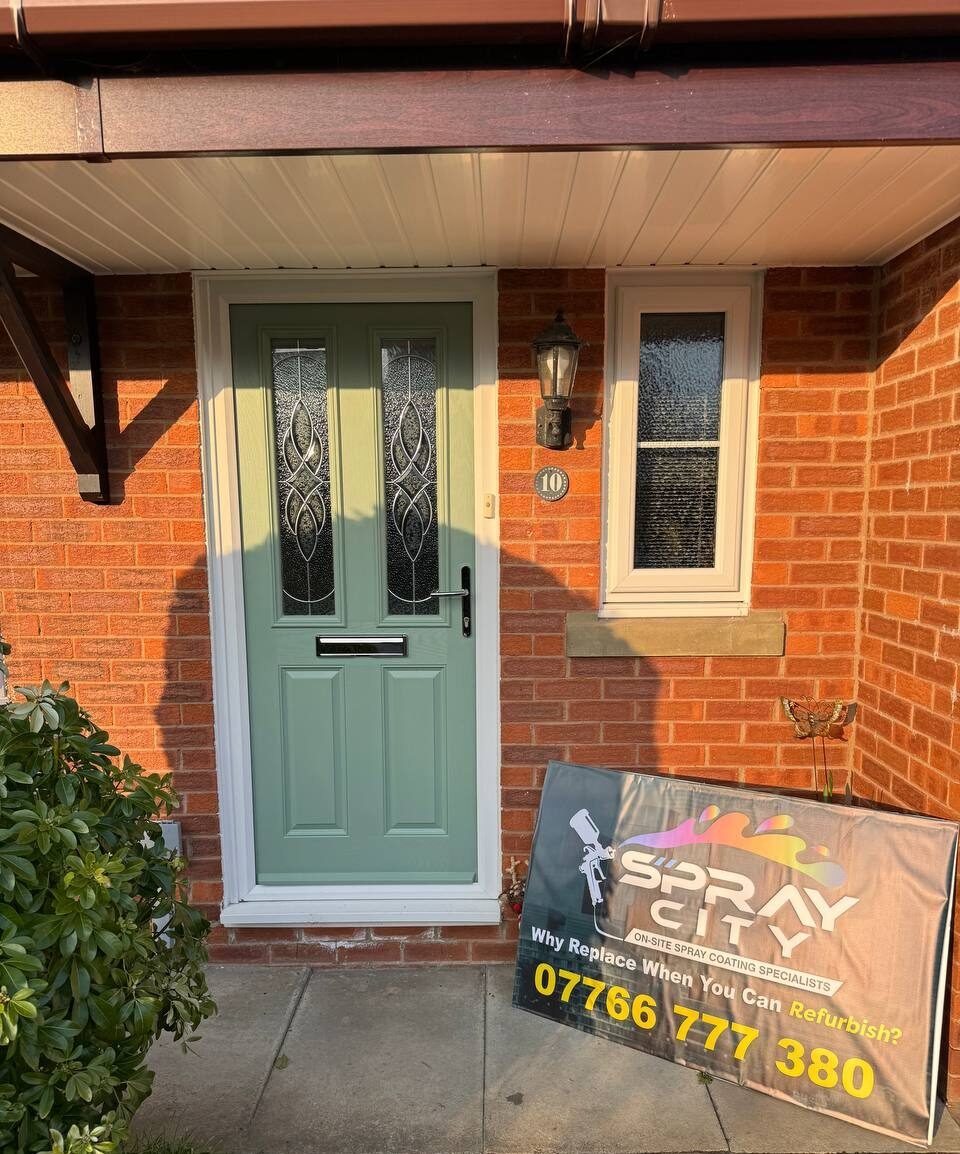
How To Choose the Perfect Paint for Your Door Spraying
Selecting the appropriate paint is crucial for a successful door spraying project. Here’s what to consider:
- Paint Type: Opt for a high-quality, water-based or oil-based paint specifically designed for interior doors. Water-based paints offer faster drying times and easier cleanup, while oil-based paints provide a more durable finish.
- Finish: Choose from a variety of finishes, including gloss, satin, or eggshell. Gloss offers a high-shine finish, ideal for modern interiors. Satin provides a soft sheen, perfect for most living areas. Eggshell offers a low-sheen finish that hides minor imperfections, suitable for high-traffic areas.
- Colour: Consider your existing décor and desired ambience when selecting a colour. Lighter colours create an illusion of spaciousness, while darker colours add a touch of drama and bubble.

uPVC windows and doors resprayed from White to Anthracite Gray by Spray City
Equipment Needed For Door Spraying
If you’re keen on DIY, you might be considering handling the door spraying yourself. If this is your case, it’s important to know exactly what you’ll be needing and for what. Here’s a breakdown of the equipment typically required for door spraying:
- HVLP Paint Sprayer: This is the most significant investment. Choose an HVLP (High Volume, Low Pressure) sprayer suitable for doors. These offer better control and use less paint compared to regular sprayers.
- Safety Gear: Protecting yourself is crucial as paint fumes can be pretty harmful. Necessary safety gear include a respirator with organic vapour cartridges to filter paint fumes, safety glasses or a full-face mask, and gloves resistant to the paint type you’re using.
- Drop Cloths: Plastic sheeting or dust sheets are useful to protect your work area from paint overspray.
-
Sanding Materials:
Fine-grit sandpaper for prepping the door surface by removing imperfections and ensuring smooth adhesion of paint.
- Cleaning Materials: Lint-free rags, cloths, and a tack cloth for cleaning the doors before painting.
- Primer: A high-quality primer suitable for the paint you’ll be using.
- Paint: Choose a good quality paint specifically formulated for spraying doors. Consider factors like durability, finish (gloss, satin, eggshell), and drying time.
- Stirring Stick: For mixing paint thoroughly.
- Paint Strainer: Straining the paint helps eliminate any lumps or debris that could clog the sprayer nozzle. This is not compulsory though.
- Screwdrivers: For removing door hardware.
- Masking Tape: Useful for masking off areas you don’t want painted, like around the door frame.
- Ladder or Work Platform: If you’re spraying taller doors, a sturdy ladder or work platform may be necessary.
- Cleaning Solvents: For cleaning the sprayer and equipment after use (ensure proper disposal of these materials).

Patio Door masked and resprayed from white to black in the UK by Spray City
Professional door spraying companies will have a more extensive range of equipment, including:
- Industrial-grade HVLP Sprayers: These have higher power and are more efficient for faster completion of larger projects.
- Spray Booths: Enclosed ventilated areas specifically designed for spray painting, ensuring a controlled environment and minimal overspray.
- Air Compressors: For powering some HVLP sprayers and providing compressed air for cleaning and other tasks.
- Advanced Personal Protective Equipment (PPE): Professionals may have heavy-duty respirators, full body suits, and other specialised equipment depending on the paint type and project requirements.
Investing in high-quality equipment will contribute significantly to achieving a professional finish. If you’re unsure about a particular product or have questions about compatibility, consult a paint specialist at your local hardware store.
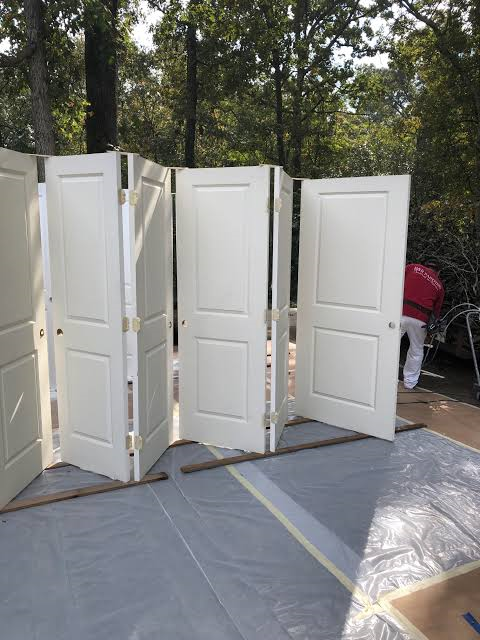
Freshly-painted Doors
Credit: Google Images
A Step-by-Step Process On Door Spraying
If you’re determined to give DIY door spraying a go, here’s a step-by-step guide to follow:
- Gather Your Supplies: Ensure you have all the necessary equipment as outlined earlier.
- Prepare the Work Area: Choose a well-ventilated workspace with plenty of room to manoeuvre the doors. Lay down drop cloths to protect the floor and surrounding areas.
- Remove Hardware: Unscrew hinges, handles, and any other door hardware to avoid getting paint on them.
- Clean the Doors: Wipe down the doors thoroughly with a damp cloth to remove dust, grime, and any greasy residues.
- Sanding: Using fine-grit sandpaper, sand the entire surface of the doors to create a smooth texture. This will help the primer and paint adhere better.
- Apply Primer: Use a high-quality primer suitable for the chosen paint type. Apply a thin, even coat of primer and allow it to dry completely following the manufacturer’s instructions.
- Set Up the Sprayer: Carefully read the instructions for your specific paint sprayer model. Thin the paint according to the manufacturer’s recommendations and fill the sprayer reservoir.
- Test Spraying:
- Before taking the doors, practice using the sprayer on a piece of cardboard or scrap wood. This allows you to adjust the spray settings, such as the air pressure and paint flow, and ensure proper spray pattern and paint consistency to achieve a smooth, even application.
-
Spray Painting the Doors:
- Begin by spraying the edges and recessed panels of the door. Hold the sprayer at a consistent distance (around 8-12 inches) and move it with a steady side-to-side motion, maintaining a slight overlap with each pass.
- Once the edges and panels are coated, spray the flat surface of the door. Use long, even strokes, keeping the sprayer parallel to the surface and maintaining a consistent overlap.
- Apply thin coats, allowing each coat to dry thoroughly before applying the next. This helps to prevent drips and runs.
- Once the first coat is dry, inspect the surface for any missed spots, drips, or imperfections. You can lightly sand any minor imperfections before applying a second coat.
- It’s generally recommended to apply 2-3 thin coats for optimal coverage and a flawless finish.
-
Drying Time:
Allow the paint to dry completely between coats and before reattaching the hardware. This could take anywhere from a few hours to a couple of days for full curing. Refer to the paint manufacturer’s drying time recommendations.
-
Clean Up:
While the paint is still wet, thoroughly clean the sprayer following the manufacturer’s instructions. This prevents paint from drying and clogging the equipment.
-
Reattach Hardware:
Once the paint is completely dry, carefully reattach the door hardware and place the doors back on their hinges.
How Much Does Door Spraying Cost?
Factors that influence the cost of spraying your door range from location, number of doors, size, material, condition to choice of paint and level of service. As a general estimate however, expect to pay anywhere from £150-£300 per door for professional spraying of a standard-sized internal door. This includes labour, materials, and any necessary equipment.

The Benefits of Hiring Professional Doors Sprayers
While DIY door spraying is achievable and can be a great pastime, hiring a professional company offers significant advantages:
- Expertise and Experience: Professional spray painters have the expertise and experience to handle any type of door in any condition and still deliver a great finish.
- High-Quality Equipment: They use top-of-the-line spray equipment that guarantees a smooth, even application and efficient completion which are either inaccessible or cannot be handled by nonprofessional sprayers.
- Preparation: The preparing before spraying of a professional and that of a DIYer carry significant differences. Professionals take care of thorough door preparation, including sanding, priming, and masking, ensuring optimal paint adhesion and a long-lasting finish.
- Safety and Clean Up: They handle all safety measures and ensure a meticulous clean-up process, minimising disruption to your home.
- Time Saving: Hiring professionals saves you valuable time and allows you to focus on other tasks.
- Wider Range of Services: Professional companies can handle various door types, including internal doors, external doors, uPVC doors, and fire doors. They can also advise on the most suitable paint and finishes for your specific needs.
- Peace of Mind: Professionals back their work with guarantees, offering peace of mind and ensuring a satisfactory outcome.

The Spray City Difference
At Spray City, we are your trusted professionals for a guaranteed, excellent finish and a stress-free experience. We offer high-quality spray paints, expert advice, and a team of experienced spray painters to deliver exceptional results.
Contact us today for a free quote and let us help you transform your home into a mural that showcases your personal style and creativity!
Conclusion
Doors spraying is an excellent way to renovate the look of your interior doors, turning a tired and worn appearance into a clean and modern aesthetic. Whether you choose to handle the project yourself or entrust it to a professional company, this guide has equipped you with the knowledge to make an informed decision.


